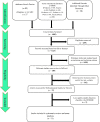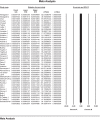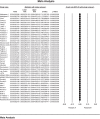Global prevalence of Duchenne and Becker muscular dystrophy: a systematic review and meta-analysis
- PMID: 35168641
- PMCID: PMC8848641
- DOI: 10.1186/s13018-022-02996-8
Global prevalence of Duchenne and Becker muscular dystrophy: a systematic review and meta-analysis
Abstract
Background: A variety of mutations in the largest human gene, dystrophin, cause a spectrum from mild to severe dystrophin-associated muscular dystrophies. Duchenne (DMD) and Becker (BMD) muscular dystrophies are located at the severe end of the spectrum that primarily affects skeletal muscle. Progressive muscle weakness in these purely genetic disorders encourages families with a positive history for genetic counseling to prevent a recurrence, which requires an accurate prevalence of the disorder. Here, we provide a systematic review and meta-analysis to determine the prevalence of DMD and BMD worldwide.
Method: The current systematic review and meta-analysis was carried out using Cochrane seven-step procedure. After determining the research question and inclusion and exclusion criteria, the MagIran, SID, ScienceDirect, WoS, ProQuest, Medline (PubMed), Embase, Cochrane, Scopus, and Google Scholar databases were searched to find relevant studies using defined keywords and all possible keyword combinations using the AND and OR, with no time limit until 2021. The heterogeneity of studies was calculated using the I2 test, and the publication bias was investigated using the Begg and Mazumdar rank correlation test. Statistical analysis of data was performed using Comprehensive Meta-Analysis software (version 2).
Results: A total of 25 articles involving 901,598,055 people were included. The global prevalence of muscular dystrophy was estimated at 3.6 per 100,000 people (95 CI 2.8-4.5 per 100,000 people), the largest prevalence in the Americans at 5.1 per 100,000 people (95 CI 3.4-7.8 per 100,000 people). According to the subgroup analysis, the prevalence of DMD and BMD was estimated at 4.8 per 100,000 people (95 CI 3.6-6.3 per 100,000 people) and 1.6 per 100,000 people (95 CI 1.1-2.4 per 100,000 people), respectively.
Conclusion: Knowing the precise prevalence of a genetic disorder helps to more accurately predict the likelihood of preventing its occurrence in families. The global prevalence of DMD and BMD was very high, indicating the urgent need for more attention to prenatal screening and genetic counseling for families with a positive history.
Keywords: Becker; Duchenne; Meta-analysis; Muscular dystrophy; Systematic review.
© 2022. The Author(s).
Conflict of interest statement
The authors declare that they have no conflict of interest.
Figures




Similar articles
-
Epileptic disorders in Becker and Duchenne muscular dystrophies: a systematic review and meta-analysis.J Neurol. 2022 Jul;269(7):3461-3469. doi: 10.1007/s00415-022-11040-y. Epub 2022 Mar 1. J Neurol. 2022. PMID: 35229191 Review.
-
Dystrophin Genotype and Risk of Neuropsychiatric Disorders in Dystrophinopathies: A Systematic Review and Meta-Analysis.J Neuromuscul Dis. 2023;10(2):159-172. doi: 10.3233/JND-221586. J Neuromuscul Dis. 2023. PMID: 36565132 Free PMC article. Review.
-
Signs and symptoms of Duchenne muscular dystrophy and Becker muscular dystrophy among carriers in The Netherlands: a cohort study.Lancet. 1999 Jun 19;353(9170):2116-9. doi: 10.1016/s0140-6736(98)10028-4. Lancet. 1999. PMID: 10382696
-
Prevalence and Genetic Profile of Duchene and Becker Muscular Dystrophy in Puerto Rico.J Neuromuscul Dis. 2016 May 27;3(2):261-266. doi: 10.3233/JND-160147. J Neuromuscul Dis. 2016. PMID: 27854217 Free PMC article.
-
Patients with Duchenne muscular dystrophy are significantly shorter than those with Becker muscular dystrophy, with the higher incidence of short stature in Dp71 mutated subgroup.Neuromuscul Disord. 2017 Nov;27(11):1023-1028. doi: 10.1016/j.nmd.2017.06.007. Epub 2017 Jun 19. Neuromuscul Disord. 2017. PMID: 28734761
Cited by
-
Utility of exome sequencing for the diagnosis of pediatric-onset neuromuscular diseases beyond diagnostic yield: a narrative review.Neurol Sci. 2024 Apr;45(4):1455-1464. doi: 10.1007/s10072-023-07210-z. Epub 2023 Nov 22. Neurol Sci. 2024. PMID: 37989827 Free PMC article. Review.
-
Drosophila Models Reveal Properties of Mutant Lamins That Give Rise to Distinct Diseases.Cells. 2023 Apr 12;12(8):1142. doi: 10.3390/cells12081142. Cells. 2023. PMID: 37190051 Free PMC article.
-
Synthetic datasets for open software development in rare disease research.Orphanet J Rare Dis. 2024 Jul 15;19(1):265. doi: 10.1186/s13023-024-03254-2. Orphanet J Rare Dis. 2024. PMID: 39010138 Free PMC article.
-
Characterization of patients with Duchenne muscular dystrophy across previously developed health states.PLoS One. 2024 Oct 30;19(10):e0307118. doi: 10.1371/journal.pone.0307118. eCollection 2024. PLoS One. 2024. PMID: 39475941 Free PMC article.
-
Pharmacological Treatments and Therapeutic Targets in Muscle Dystrophies Generated by Alterations in Dystrophin-Associated Proteins.Medicina (Kaunas). 2024 Jun 27;60(7):1060. doi: 10.3390/medicina60071060. Medicina (Kaunas). 2024. PMID: 39064489 Free PMC article. Review.
References
-
- Mah JK, Selby K, Campbell C, Nadeau A, Tarnopolsky M, McCormick A, et al. A population-based study of dystrophin mutations in Canada. Can J Neurol Sci. 2011;38(3):465–474. - PubMed
-
- Hammonds RG., Jr Protein sequence of DMD gene is related to actin-binding domain of α-actinin. Cell. 1987;51(1):1. - PubMed
-
- Davison MD, Critchley DR. alpha-Actinins and the DMD protein contain spectrin-like repeats. Cell. 1988;52(2):159–160. - PubMed
-
- Aartsma-Rus A, Van Deutekom JC, Fokkema IF, Van Ommen GJB, Den Dunnen JT. Entries in the Leiden Duchenne muscular dystrophy mutation database: an overview of mutation types and paradoxical cases that confirm the reading-frame rule. Muscle Nerve. 2006;34(2):135–144. - PubMed
-
- Ibraghimov-Beskrovnaya O, Ervasti JM, Leveille CJ, Slaughter CA, Sernett SW, Campbell KP. Primary structure of dystrophin-associated glycoproteins linking dystrophin to the extracellular matrix. Nature. 1992;355(6362):696–702. - PubMed
Publication types
MeSH terms
Substances
Grants and funding
LinkOut - more resources
Full Text Sources
Medical

